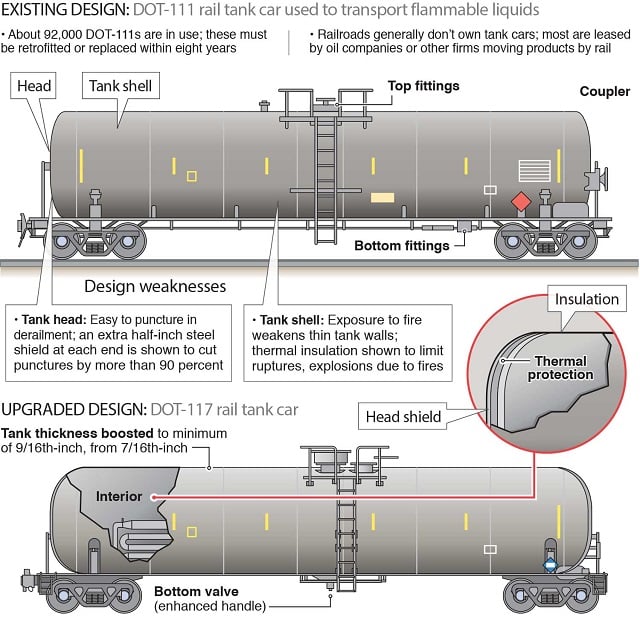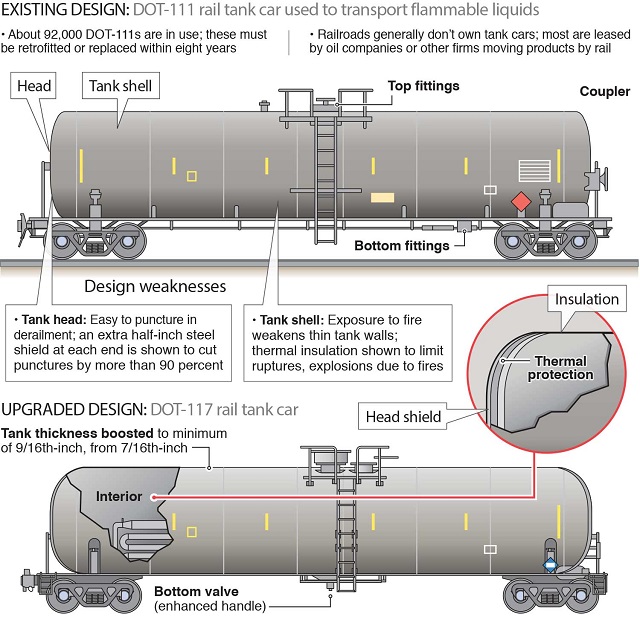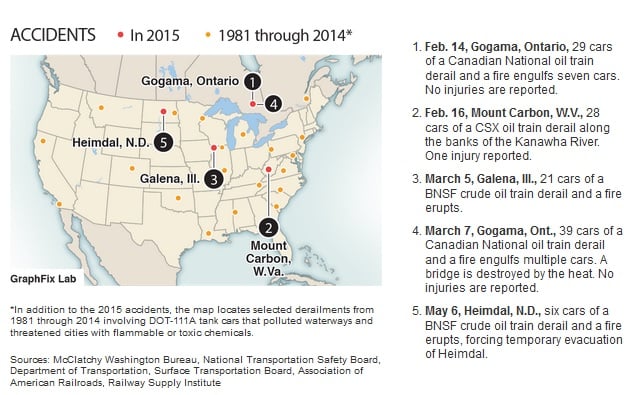
Washington – Lawmakers and environmental and industry groups criticized the federal government’s new safety measures for oil trains when they were announced earlier this month. Now another group has expressed disappointment in the new rules:
Emergency responders. They’re among the first in danger when a fiery derailment happens.
After another oil train derailed and caught fire, this time in North Dakota and the fifth in North America this year, firefighters renewed their call for more training and information about hazardous rail shipments.
The International Association of Fire Fighters’ primary objection to the new rules is about their information-sharing requirements. But Elizabeth Harman, an assistant to the general president of the group, also said firefighters needed more training on responding to hazardous materials incidents. The rule didn’t directly address that issue, though some lawmakers have sought additional funding.
“The training that’s needed has been developed,” she said. “This is the first step that needs to be funded and expanded for all first responders.”
Harman said her group had been talking to the Federal Emergency Management Agency about making more competitive grants available for first-responder training.
Tank cars still showing accident vulnerability
Tens of thousands of rail tank cars haul flammable liquids, such as crude oil and ethanol, across North America, and most have weak spots that make them vulnerable to puncture and fire in an accident. A new tank car design has been approved, but is not widely available yet. There have been five serious oil train derailments so far this year.


Since 2010, an exponentially larger volume of flammable liquids, especially crude oil and ethanol, has been moving by rail, and with it has come an increase in risk to communities.
“We need to be prepared for it, and we’re willing to be prepared for it,” Harman said.
The rail industry and the government have funded new training for emergency responders as a result of the increased risk. Railroads train 20,000 firefighters a year in communities across the country, according to the Association of American Railroads, an industry group.
Since last summer, the rail industry has paid to send hundreds more to an advanced firefighting academy in Pueblo, Colo., designed for responding to oil train fires.
While firefighter groups have praised the industry’s efforts, 65 percent of fire departments involved in responding to hazardous materials incidents still have no formal training in that area, according to a 2010 survey by the National Fire Protection Association.
While no first responders have been injured in multiple oil train derailments and fires in the past year and a half, they’ve faced numerous challenges:
– When an oil train derailed and caught fire near Casselton, N.D., on Dec. 30, 2013, a BNSF student engineer became an ad-hoc first responder. According to interview transcripts published last month by the National Transportation Safety Board, the student donned firefighting gear and equipment as he uncoupled cars that were still on the track to move them away from the fire.
– When an oil train derailed and caught fire in downtown Lynchburg, Va., on April 30, 2014, first responders didn’t know right away which railroad to call, since two companies operate tracks through the city. According to a presentation at a conference of transportation professionals in Washington in January, it also took 45 minutes for first responders to obtain documents showing them what the train was carrying.
– After an oil train derailed and caught fire near Galena, Ill., on March 5 this year, volunteer firefighters could reach the remote site only via a bike path. Once there, they attempted to extinguish the fire, but had to retreat when they realized they couldn’t, leaving their equipment behind. According to local news reports, their radios didn’t work, either.
Harman said the U.S. Department of Transportation’s new regulations for trains carrying crude oil, ethanol and other flammable liquids didn’t go far enough with respect to information that railroads provided to communities.
Under an emergency order the department issued last May, railroads were required to report large shipments of Bakken crude oil to state emergency-response commissions, which then disseminated that information to local fire departments.
But under the department’s new rules, starting next year, railroads will no longer report the information to the states, and fire departments that want the information will have to go directly to the railroads. It also will be shielded from public disclosure.
“These new rules fall short of requiring rail operators to provide the information fire departments need to respond effectively when the call arrives,” said Harold Schaitberger, general president of the firefighters group.
Susan Lagana, a spokeswoman for the Department of Transportation, said Friday that the department was reviewing feedback from emergency responders and lawmakers to address their concerns.
She said the new rule would expand the amount of information available to first responders and noted that for now, last year’s emergency order remains in place.
Ed Greenberg, a spokesman for the Association of American Railroads, said the industry was reviewing the new regulations. He said it had shared information with first responders for years and would continue to do so.
Greenberg said the industry was developing a mobile application called AskRail that would give emergency responders immediate access to information about a train’s cargo.
“Freight railroads have ongoing dialogue with first responders, residents and local civic officials on rail operations and emergency planning,” he said.
Emergency planners in Washington state sought more information about oil trains from BNSF, including routing information, worst-case derailment scenarios, response planning and insurance coverage. On April 30, the railroad met with state fire chiefs in Olympia.
“I think both sides learned a little bit about the other group’s point of view,” said Wayne Senter, the executive director of the Washington Fire Chiefs. “I was pretty positive by the end of the meeting the information we asked for in our letter was either available or will soon be available either directly or indirectly.”
Samantha Wohlfeil of The Bellingham (Wash.) Herald contributed to this article.
3 Days Left: All gifts to Truthout now matched!
From now until the end of the year, all donations to Truthout will be matched dollar for dollar up to $38,000! Thanks to a generous supporter, your one-time gift today will be matched immediately. As well, your monthly donation will be matched for the whole first year, doubling your impact.
We have just 3 days left to raise $38,000 and receive the full match.
This matching gift comes at a critical time. As Trump attempts to silence dissenting voices and oppositional nonprofits, reader support is our best defense against the right-wing agenda.
Help Truthout confront Trump’s fascism in 2026, and have your donation matched now!